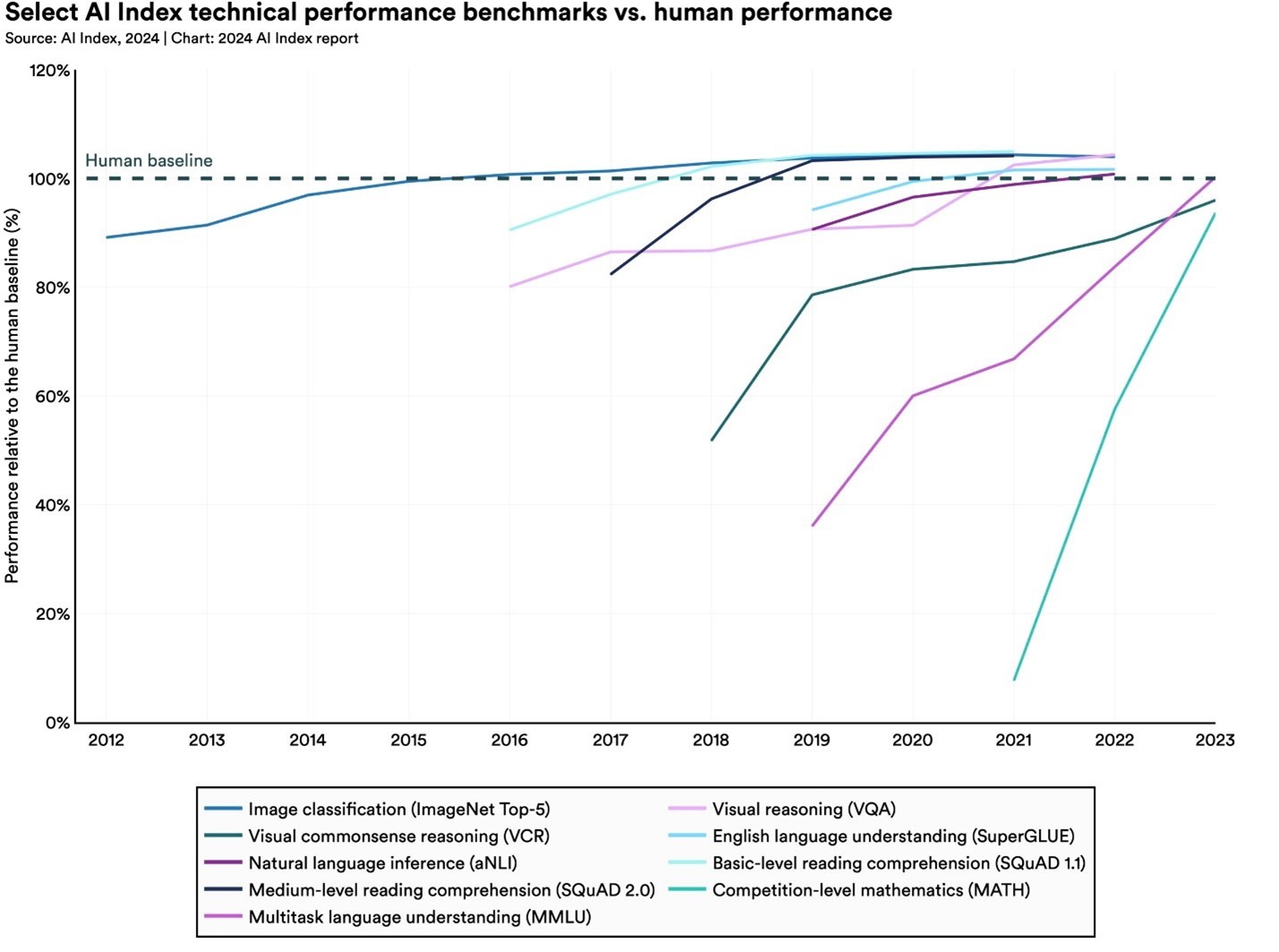Artificial Intelligence (AI) is rapidly transforming the world as we know it. From Google Maps and smart speakers to virtual assistants and wearable technology, AI is influencing various aspects of our daily lives. As AI continues to evolve, people naturally compare it to human intelligence, leading to interesting conversations about what each does well and where they fall short.
Recent revolutions in computing power, data availability, and advanced algorithms have enabled AI to outperform humans in certain areas. According to the 2024 AI Index Report* published by Stanford University, AI has surpassed human performance in a few key areas.

The figure above illustrates the progress of AI systems relative to human baselines for nine AI benchmarks corresponding to nine tasks. Tracking progress on benchmarks has been a standard way for the AI community to monitor the advancement of AI systems. Significant progress has been made over the last five years in the field of AI. AI has helped to cut down the workforce effort for repetitive tasks, reduced time and effort on tasks that demanded reading comprehension, speech recognition/transcription to name a few. More importantly, AI has enabled humans in better decision-making by helping gather contextually relevant information faster.
- Image Classification: ImageNet is a canonical AI benchmark that features a large collection of labeled images, and AI systems are tasked with classifying these images accurately. As you can see, AI has surpassed human baselines on image classification in 2015.
- Reading Comprehension: At typical reading speeds of 200 – 400 words per minute, it would take a person over 5 hours to get through 80,000 words. Anthropic’s Claude can digest 80,000 words, equivalent to a 330-page book in just about 30 seconds.
- Speech Recognition/Transcription: OpenAI’s Whisper-v2 has a median Word Error Rate (WER) of 8.06% and takes 10-30 minutes on average to transcribe one hour of audio. The average person can transcribe one hour of audio in about four hours.
However, despite these advancements, it remains far-fetched to think that AI could replace human intelligence at the workplace. Human intelligence encompasses unique capabilities that AI has yet to replicate fully, particularly in areas such as logic, creativity, emotional intelligence, and morality.
- Emotional intelligence: This allows humans to form relationships, as they can understand and respond to emotions, show empathy, and react accordingly. However, AI can’t express emotions, and they mimic human feelings to respond politely and avoid offending users.
- Creativity: Humans are creative, and they can come up with fresh ideas. Whether they’re creating art or solving a problem, they can produce original work. On the other end, AI mostly creates by combining multiple ideas that’s based on trained data.
- Morality: Humans possess a sense of morality and ethics that guide our actions and decisions. Deciding whether to do something based on the condition and dignity of others is what distinguishes us as humans. But for AI, it’s at a nascent stage and is still evolving to achieve the same level of morality as humans.
As AI reshapes our workplace and workforce, it is imperative for the organization to harness the emotional intelligence, foster creativity and uphold ethical standards to enhance employee experience, improve productivity, reduce risks, and achieve competitive advantage and innovation.
The relationship between Human Intelligence (HI) and Artificial Intelligence (AI) need not be seen as a competition. Instead, there is immense potential for collaboration, where AI augments human capabilities, allowing humans to focus on higher-level tasks that require ingenuity, creativity, and ethical reasoning. For example, AI-powered virtual assistants can handle routine inquiries and tasks, freeing up human employees to provide more personalized and complex support to customers.
Additionally, by fostering a culture of collaboration between HI and AI, we can pave the way for innovative solutions that not only enhance employee experience but also boost productivity at the workplace while upholding ethical standards. Together, we can create a future where technology serves humanity, unlocking extraordinary potential for all. In conclusion, it is up to us, as individuals and as a society, to embrace the collaborative potential of AI and HI, and to shape a future where both forms of intelligence work in harmony to address the challenges and opportunities for what’s next at work.








